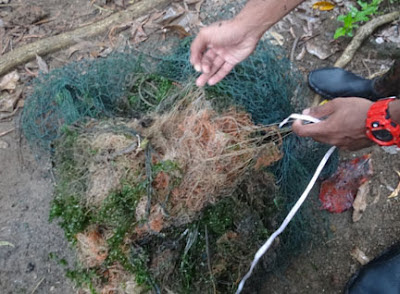 |
| Andy, Marcus and Hussain working along the same net entwined around mangrove roots. |
The net is quite badly embedded among the roots, so it's back breaking work.
Oh no, a small crab (4.5cm body width) is stuck in one of the nets. I managed to get it free and it was fine. It had all its limbs so it was probably only recently entangled in it. Abandoned nets continuously trap and kill all kinds of animals until they are removed. Fortunately, we did not find any other animals live or dead in the rest of the nets that we removed.
After the nets are carefully removed, they are packed into blue bags for hauling out and disposal.
Andy and Marcus packing the bags.
Hussain working on a pile of nets.
Hussain also worked hard on this batch of thick nets that are not used for catching fish but are used in fish farms to form their floating cages.
Here's Hussain getting into the very entangled net.
+m6.jpg) |
| Photo by Andy Dinesh |
Being of weak back, I headed further down the shore to deal with nets that are easier to remove. Like this one that is only draped on the roots and not deeply entwined.
Another bunch that seems to have washed up recently.
And another small clump.
I found this longer stretch of nets under a very prickly tree.
I crept under the thorny bush, got comfy and started gnawing at the net with my little $1 kindergarten scissors. Which actually work very well.
While Hussain worked on a pile of nets draped on the bush.
After I managed to cut through most of the net, Marcus gives the net a good tug and hurray, it's free to be removed. Andy is taking photos of what is going on.
While Andy lifts the thorny bush aside, Marcus tries to give a good tug to the remaining bunch of nets. Alas, it's anchored by a very thick rope and we can't get it free. We'll have to come back another day to get it done, as it started raining and the sun is setting!
There is still a humungous net entwined around this abandoned rotting boat. We had not time to remove it so Hussain is mobilising a team to do it possibly later this week. Hurray!
It's time to pack up all the bags and haul them out.
We also get some data about the nets. Measuring the mesh size and total volume of nets.
Andy took photos of the nets and shared these photos. There were about 5 pile of nets, each about 60cm x 50cm x 25cm in volume. A total of about 3.75 cubic metres of net!
There are some nets made of monofilament plastic with a mesh size of about 4-5cm while some were larger, about 10cm. There were some nets made of a woven fibre which seems to be made up of several layers, with a very large mesh size of about 20cm and another layer of tiny mesh size of 2-4cm. There were also thicker nets probably used in the cages on fish farms.
 |
| Photos by Andy Dinesh |
Thanks to Hussain, Andy and Marcus for coming for this trip! Hussain will be looking at the data we have been collecting this past year. His research on this issue locally and globally will help us better understand and hopefully manage this heartbreaking issue on our shores. This trip has been funded from the generous donation by Aardwolf Pestkare as part of their very kind project to feature wildsingapore photos on their 2012 calendar.












+m6.jpg)
+m6.jpg)







No comments:
Post a Comment